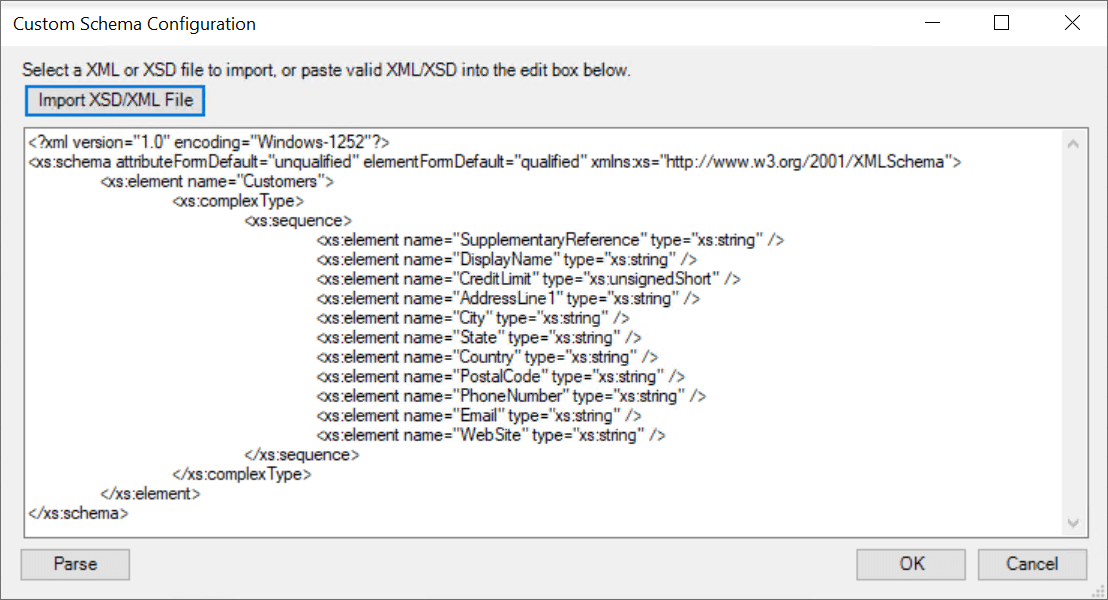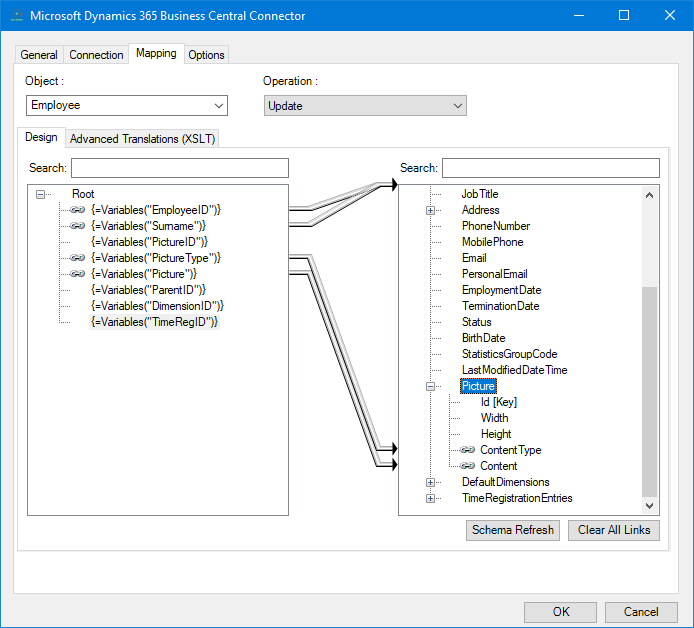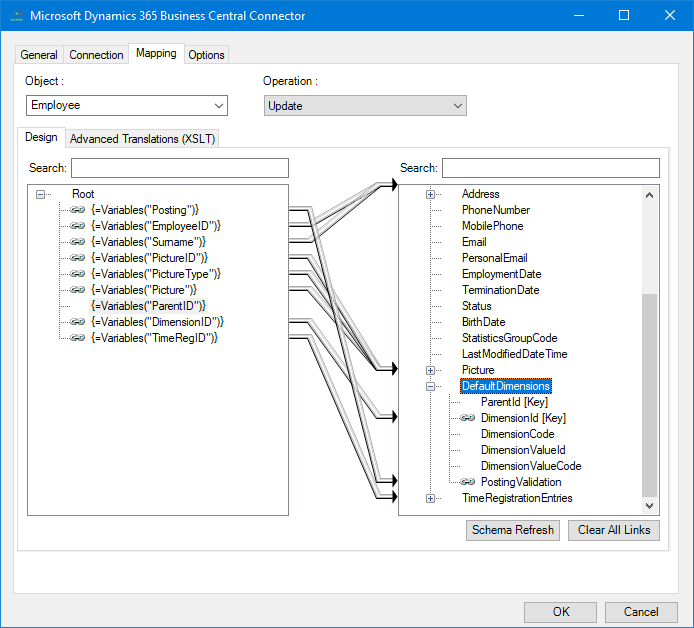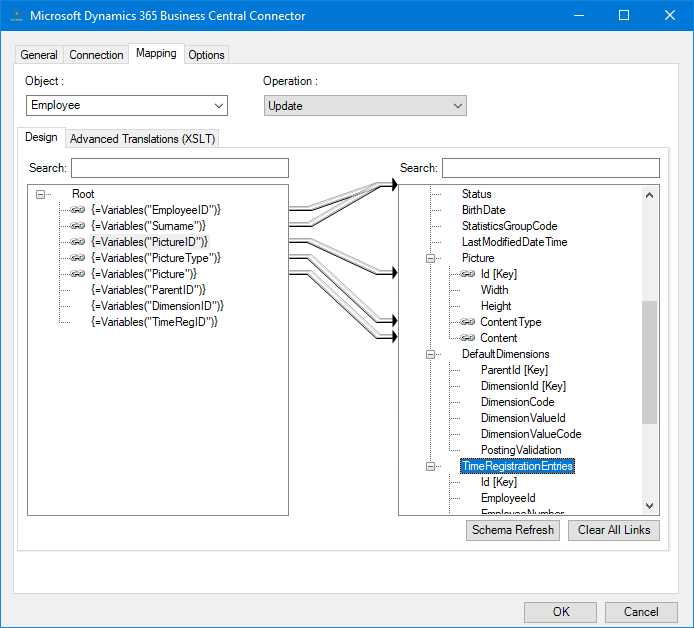- What is the Microsoft Dynamics 365 Business Central Connector
- Microsoft Dynamics 365 Business Central Connector Video Overview
- White Paper - Microsoft Dynamics 365 Business Central Connector
- Microsoft Dynamics 365 Business Central Connector Architecture
- Microsoft Dynamics 365 Business Central Connector – Working with Other Tools
- Microsoft Dynamics 365 Business Central Connector – Global Configuration
- Microsoft Dynamics 365 Business Central Connector – Step Configuration
What is the Microsoft Dynamics 365 Business Central Connector
Use the Microsoft Dynamics 365 Business Central Connector to send and retrieve data between BPA Platform and your Microsoft Dynamics 365 Business Central installation. This allows for data to be synchronised between Microsoft Dynamics 365 Business Central and third-party systems that it does not normally connect with.
All communication uses XML; BPA Platform recordsets cannot be used as data inputs unless converted to XML first (using the Convert Recordset to XML tool, for example). You use the Connector to map BPA Platform data to Microsoft Dynamics 365 Business Central objects and operations. Standard operations of READ, ADD, UPDATE, and DELETE are supported as well as custom operations for specific objects. All objects available from the Microsoft Dynamics 365 Business Central API are supported, including codeunits, pages, and queries.
XML responses received back from the Microsoft Dynamics 365 Business Central API can be saved and used by other BPA Platform tools for further processing
The Microsoft Dynamics 365 Business Central Connector Tool Pack
The tool pack consists of:
- Microsoft Dynamics 365 Business Central Agent — The Agent communicates directly with the Microsoft Dynamics 365 Business Central API. It can be installed on any computer that has access to both the BPA Platform server and the Microsoft Dynamics 365 Business Central company database, local to the BPA Platform server, or the on-premise server instance hosting the Microsoft Dynamics 365 Business Central company database
- Microsoft Dynamics 365 Business Central Connector — The Connector communicates with the Microsoft Dynamics 365 Business Central Agent instead of interacting directly with the Microsoft Dynamics 365 Business Central company database. It must be installed on the BPA Platform server and any remote BPA Platform client machines which run Microsoft Dynamics 365 Business Central Connector tasks.
System Requirements
The following prerequisite software must be in place before installing the Microsoft Dynamics 365 Business Central Connector.
Minimum BPA Platform Version
The Microsoft Dynamics 365 Business Central Connector requires BPA Platform 2020 Update 1 or above.
Minimum Microsoft Dynamics 365 Business Central Version
The Microsoft Dynamics 365 Business Central Connector supports Dynamics 365 Business Central 2019 Spring Update Release or higher.
Microsoft Dynamics 365 Business Central Connector Video Overview
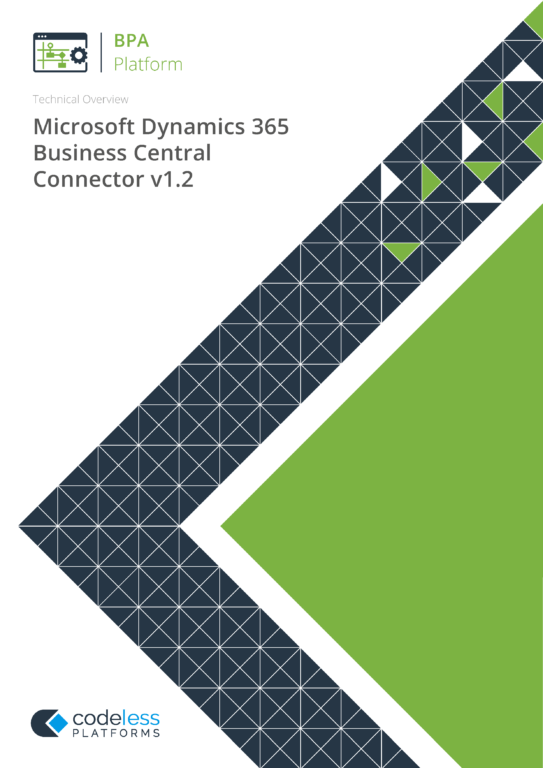
White Paper - Microsoft Dynamics 365 Business Central Connector
Microsoft Dynamics 365 Business Central Connector Architecture
The following diagrams provide example architectural layouts of the Connector with Microsoft Dynamics 365 Business Central deployed on-premise or in the cloud. Whether Microsoft Dynamics 365 Business Central has been deployed in the cloud or on-premises, you can choose to locate the Microsoft Dynamics 365 Business Central Agent on any machine accessible by the BPA Platform server or on the server itself.
Cloud Architecture
Example architecture:
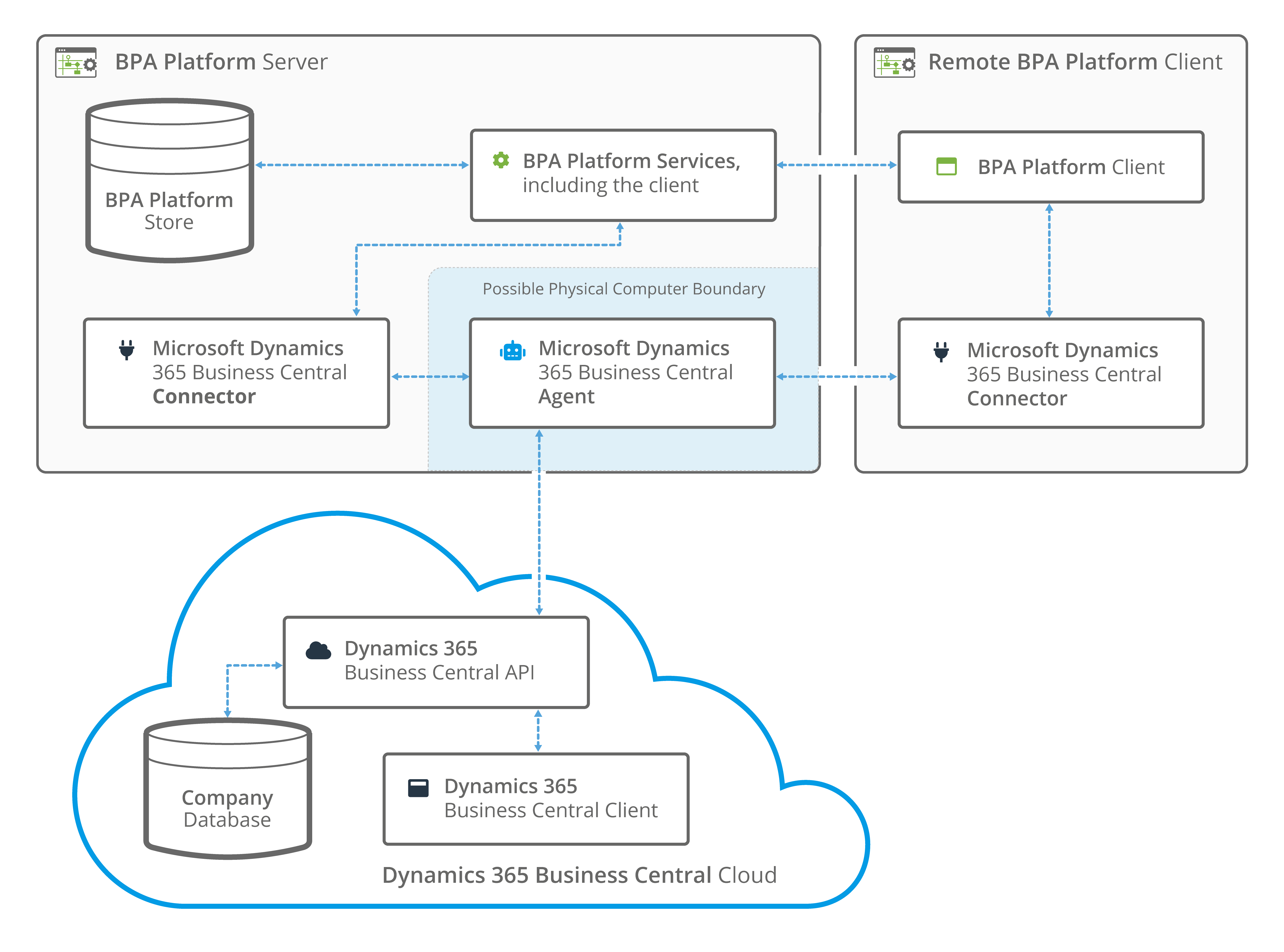
On-Premise Architecture
Example architecture:
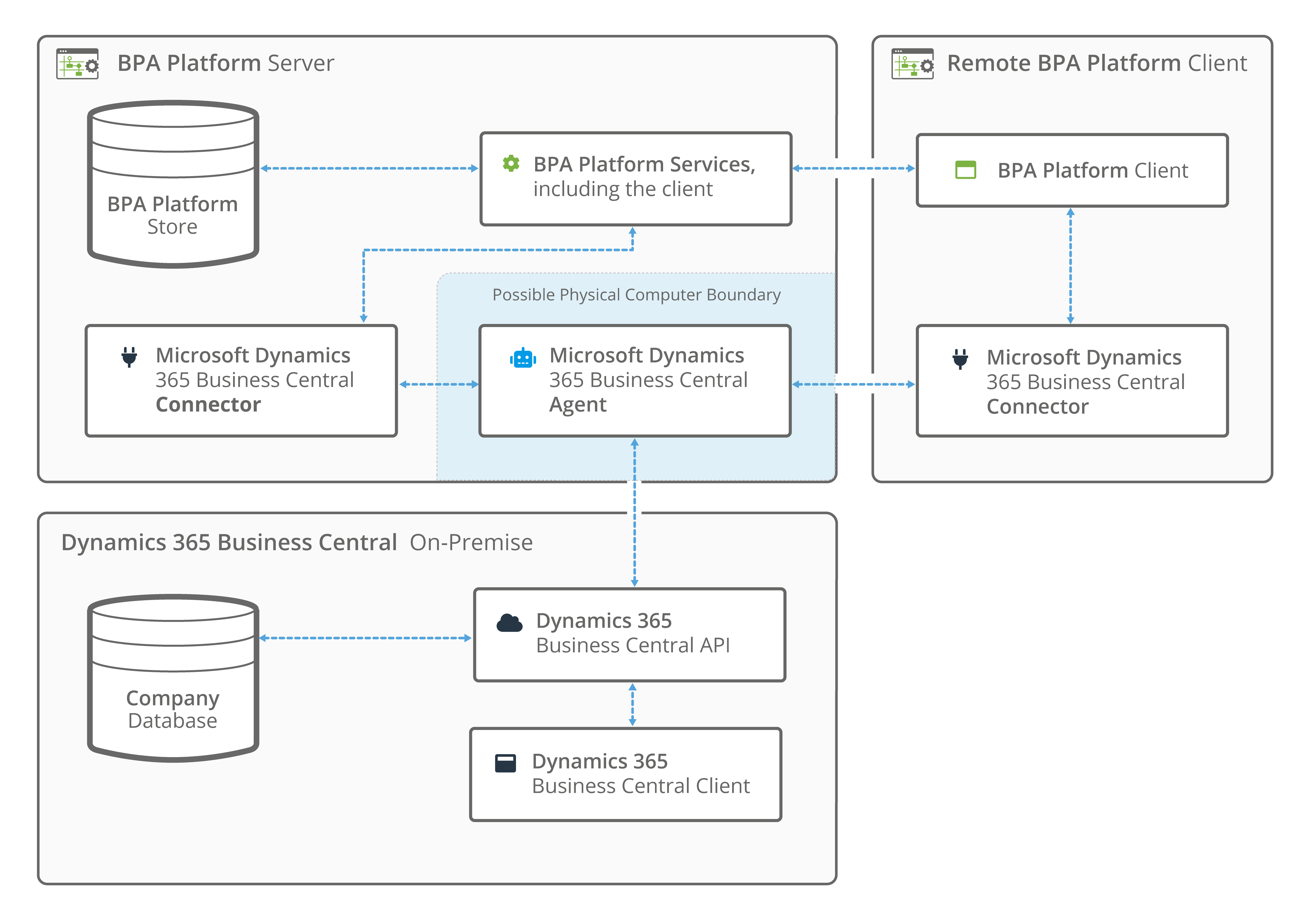
Microsoft Dynamics 365 Business Central Connector – Working with Other Tools
The Microsoft Dynamics 365 Business Central Connector tool can directly interact with the following tools:
Consuming from Other Tools
The Microsoft Dynamics 365 Business Central Connector can consume output from the following tools:
| Icon | Tool Name | Tool Category |
|---|---|---|
| Import XML Document | Input | |
| Retrieve Text Message | Input | |
| Convert Recordset to XML | Format | |
| Transform Data | Format | |
| Call Task Tool | Execute | |
| Applications Platform Connector | Data Connectors | |
| Microsoft Dynamics 365 Business Central Connector | Data Connectors |
Objects Consumed
The Microsoft Dynamics 365 Business Central Connector consumes the following objects exposed by other steps:
- XML — XML data from any BPA Platform tool capable of exposing such data (see above)
Exposing to Other Tools
The following tools can directly consume output from the Microsoft Dynamics 365 Business Central Connector:
| Icon | Tool Name | Tool Category |
|---|---|---|
| Retrieve Text Message | Input | |
| Convert XML to Recordset | Format | |
| Run Microsoft Reporting Services | Format | |
| Transform Data | Format | |
| Save File | Output | |
| Call Task | Execute | |
| Applications Platform Connector | Data Connectors | |
| Web Service Connector | Data Connectors | |
| Microsoft Dynamics 365 Business Central Connector | Data Connectors |
Objects Exposed
The Microsoft Dynamics 365 Business Central Connector tool outputs the following objects which can be consumed by other tools:
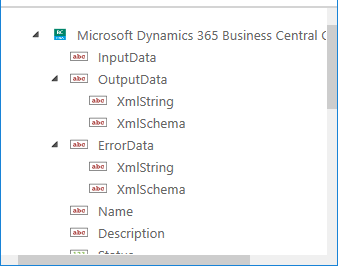
- InputData
This document contains the input XML received by the Microsoft Dynamics 365 Business Central Connector
tool. It is only available if a task step has been selected as the Data Source. - OutputData
The OutputData object contains two sub-objects:- XmlString — This is the XML document produced by the tool, containing data returned from Microsoft Dynamics 365 Business Central. Also included are the key fields for the mapped elements affected by the used operation — for example, if using an
ADDoperation, the key fields for the top-level object instances that are created are returned — and a SupplementaryReferencefield for task auditing purposes. The mapped fields in the Mapping tab (see About the Mapping Tab) define the structure of this XML document. - XmlSchema — This contains the output schema in XSD format.
- XmlString — This is the XML document produced by the tool, containing data returned from Microsoft Dynamics 365 Business Central. Also included are the key fields for the mapped elements affected by the used operation — for example, if using an
- ErrorData
The ErrorData object also contains two sub-objects:- XmlString — This contains any error data reported by Microsoft Dynamics 365 Business Central
<Error>— All errors are created as an<Error>node, with the following sub-nodes:
<Object />— The name of the requested object
<CODE />— The error code returned by Microsoft Dynamics 365 Business Central
<MESSAGE />— The corresponding error message
<EXTENDEDINFO />— A string containing additional information about the error
<INPUTDATA />— The header input data (excluding child nodes) mapped for the object, plus all data contained inSupplementaryReference
</Error> - XmlSchema — This contains the output schema in XSD format.
- XmlString — This contains any error data reported by Microsoft Dynamics 365 Business Central
- Step Properties
Standard step properties are also available allowing you to use statistical data of the Microsoft Dynamics 365 Business Central Connector step.
Where Can the XML Output be Used?
The incoming XML is translated into the XML format for the object and operation selected in the configuration. The data for the linked fields is brought across into the output XML — only those fields that are linked are brought across. The XML is passed to the Connector, which then:
- Processes the data
- Performs the operation requested
- Receives an XML document containing the response
Both the OutputData and ErrorData documents can be directly used by succeeding task steps that can consume XML data, as part of an application integration or synchronisation process. To use the documents in a non-XML consuming tool, use a Convert XML to Recordset step first to create a recordset copy of the XML data.
The XML documents are also available as consumable objects from the BPA Platform Browser (XmlString). When used in a task step, such as Format as Text or Save File, this exposes the actual XML string.
Error Handling
Errors are written to the BPA Platform Event Log (Tasks toolbar > Event Log ). You define how errors are
handled in the Options tab of the tool.
Reasons for the errors could include:
- Web service connection errors
- User privilege errors
- Errors from the API
- Errors, messages, and warnings from Microsoft Dynamics 365 Business Central
- Any reported task runtime errors, including Agent errors, such as, loss of connection
Microsoft Dynamics 365 Business Central Connector – Global Configuration
The global configuration for the Microsoft Dynamics 365 Business Central Connector is used to create connections to the Microsoft Dynamics 365 Business Central Agent.
You open this interface from the resources tree — expand System > Tools > Data Connectors and double-click Microsoft Dynamics 365 Business Central Connector in the items list.

When a connection is created, the available objects and fields of your Microsoft Dynamics 365 Business Central installation are retrieved.
Click Add to create a connection to Microsoft Dynamics 365 Business Central.
Using Extended Logging
Selecting this option exposes the XML parsed between the Connector and Microsoft Dynamics 365 Business Central.
Without extended logging, the Event Log only contains start and end of transaction messages, plus any error messages encountered at runtime.
You can view the extended log in the BPA Platform Event Log (Tasks toolbar > Event Log)
About the General Node
You must name each connection you create to a Microsoft Dynamics 365 Business Central database.
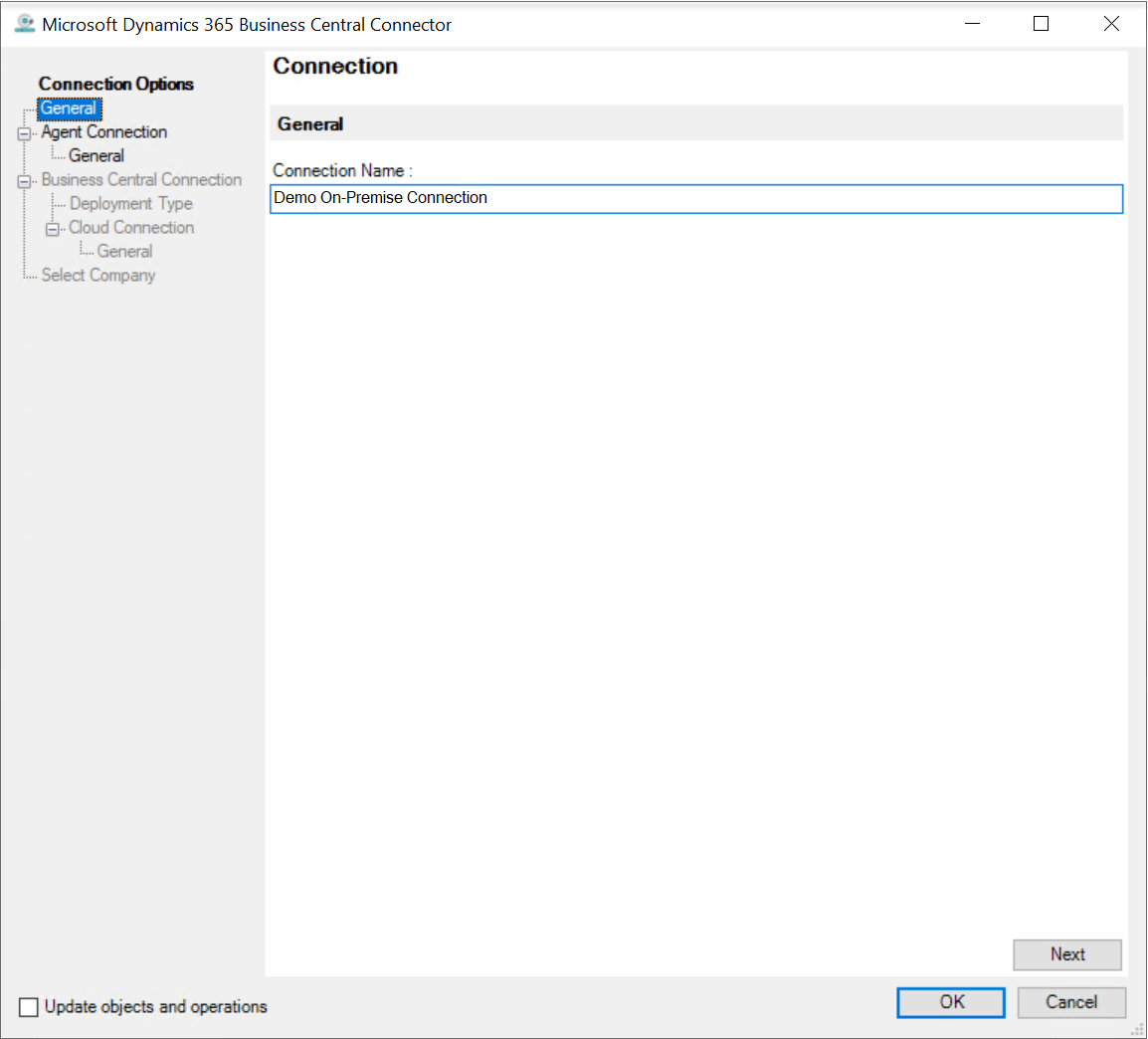
Provide a unique Connection Name. If your Microsoft Dynamics 365 Business Central installation makes use of a number of separate databases, it is recommended you add such details to the name. This is useful later when creating task steps.
Updating Objects and Operations
Enabling Update Objects and Operations allows the Microsoft Dynamics 365 Business Central schema in BPA Platform to be refreshed every time an update is made in the API itself.
Should you also upgrade Microsoft Dynamics 365 Business Central to a newer, compatible version, all related schemas within BPA Platform must be refreshed. To do this, select this option and save the changes. You must repeat this for each existing connection you have defined.
About the Agent Connection Node
The Agent Connection node provides a brief summary of any configured Microsoft Dynamics 365 Business Central Agents.
About the General Node
Use the General node to determine which Microsoft Dynamics 365 Business Central Agent this global connection is for.
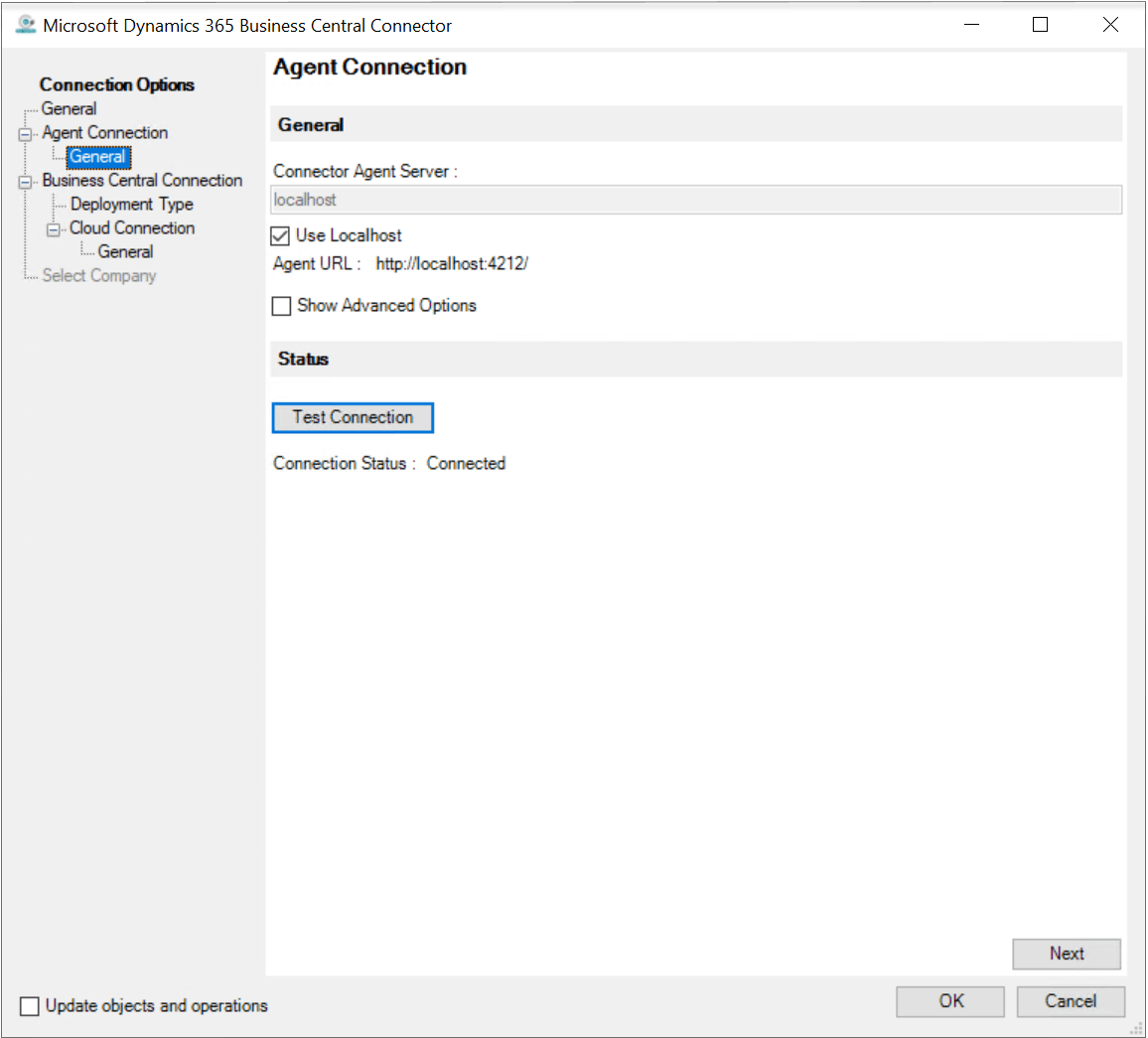
In Connector Agent Server, enter the IP address or hostname of the machine where the Microsoft Dynamics 365 Business Central Agent is installed. If the Agent is on the same machine as this instance of BPA Platform, select Use Localhost.
By default, the connection is over HTTP and port 4212. If the Agent has been set up to use HTTPS or a different port, enable Show Advanced Options.
Use Test Connection to ensure the Microsoft Dynamics 365 Business Central Connector can communicate to the Agent successfully.
About the Advanced Node
Use the Advanced node to change the communication defaults for the Dynamics 365 Business Central Agent this global connection is for. This node is hidden until Show Advanced Options in the Agent Connection > General node is selected.
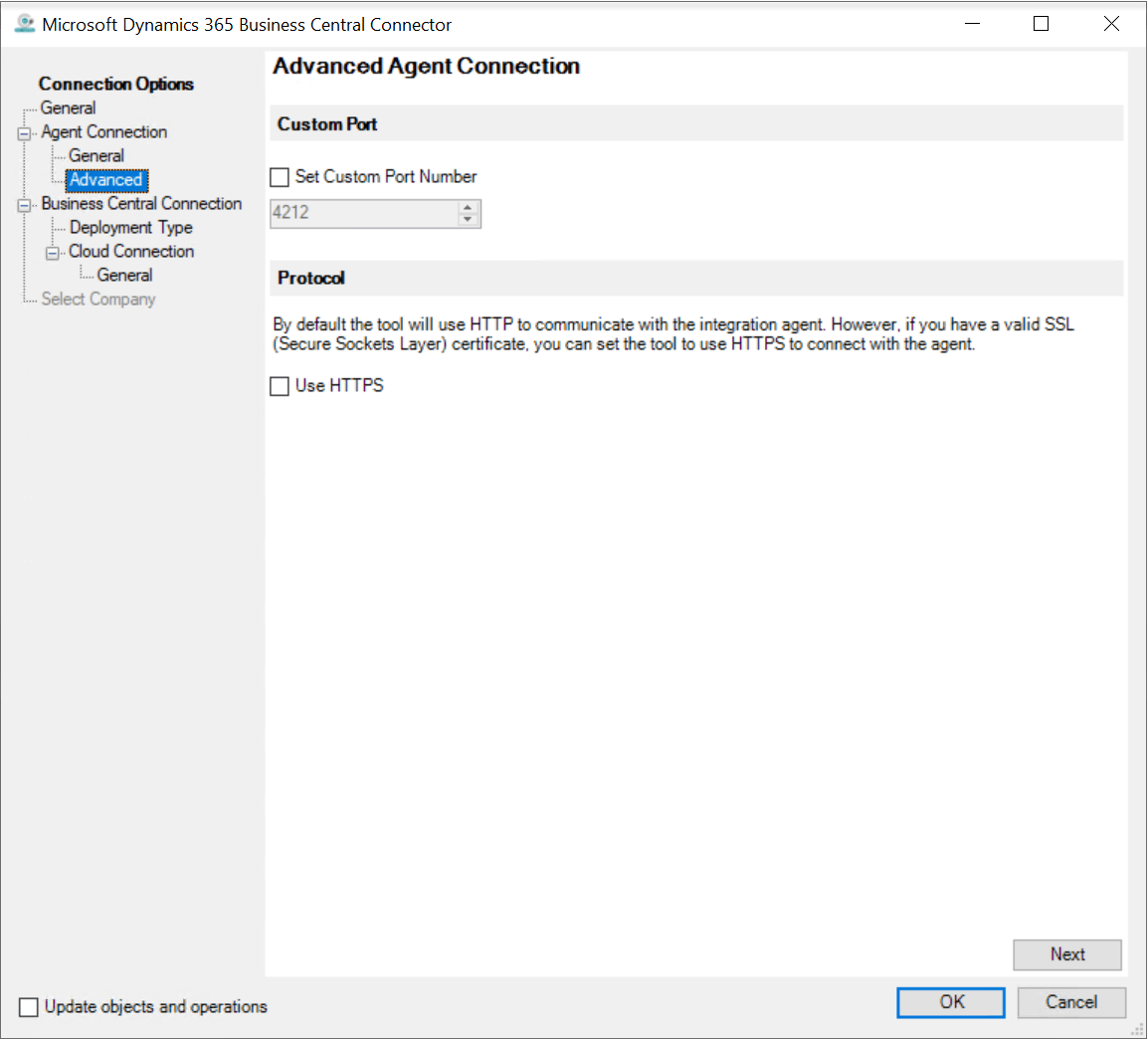
By default, the connection is over HTTP and port 4212.
To change the port used to communicate over, select Set Custom Port Number and enter the required number in the box provided.
To use HTTPS communication, select Use HTTPS.
About the Business Central Connection Node
The Business Central Connection node provides a brief summary of the configured connection to Microsoft Dynamics 365 Business Central.
About the Deployment Type Node
Use the Deployment Type node to determine whether this connection is for Microsoft Dynamics 365 Business Central in the Cloud or On-Premise.
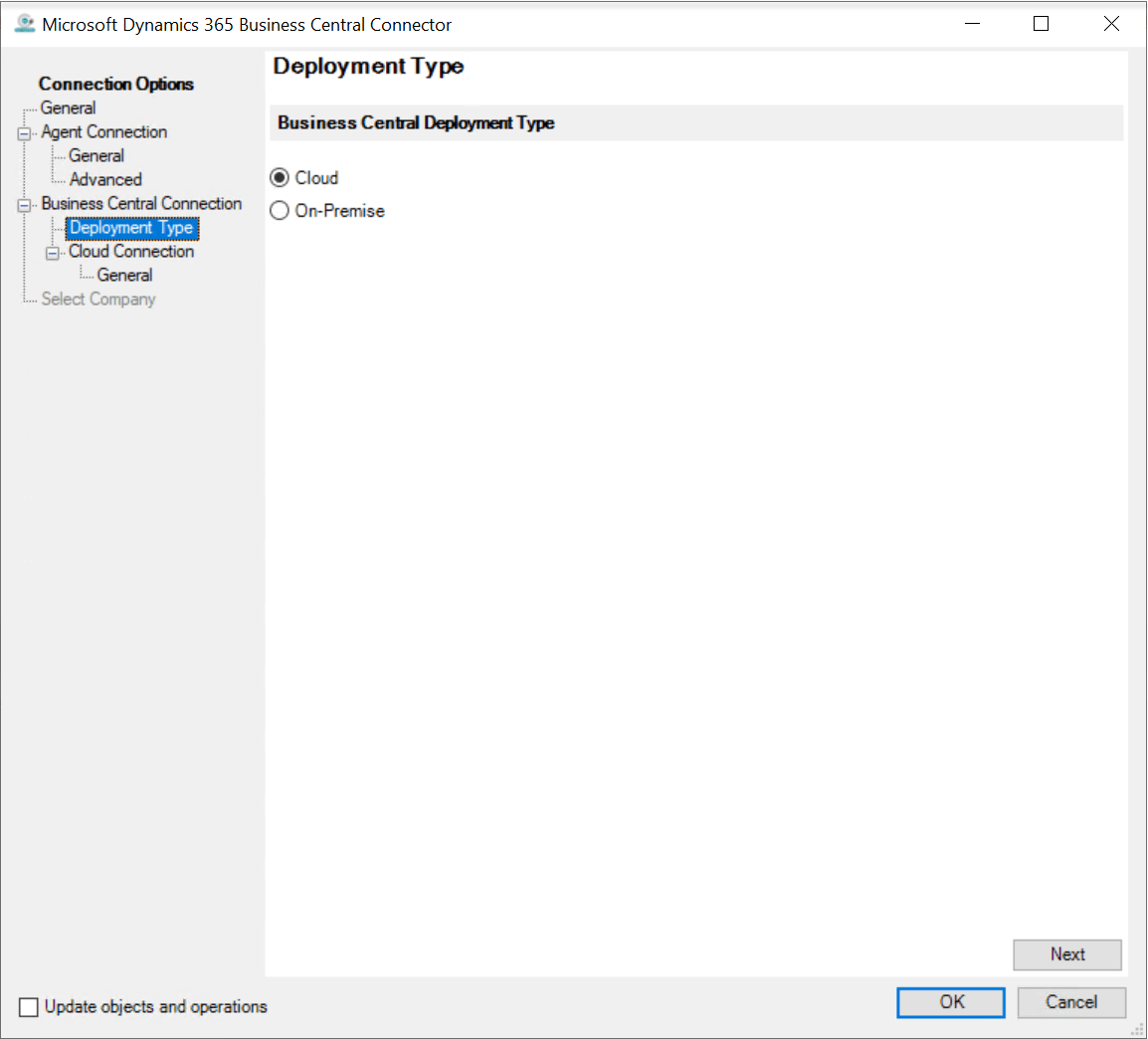
About the Cloud Connection Node
The Cloud Connection node provides a brief summary of the configured connection Microsoft Dynamics 365 Business Central in the cloud.
About the General Node
The General tab is only available when Cloud is selected as the Deployment Type.
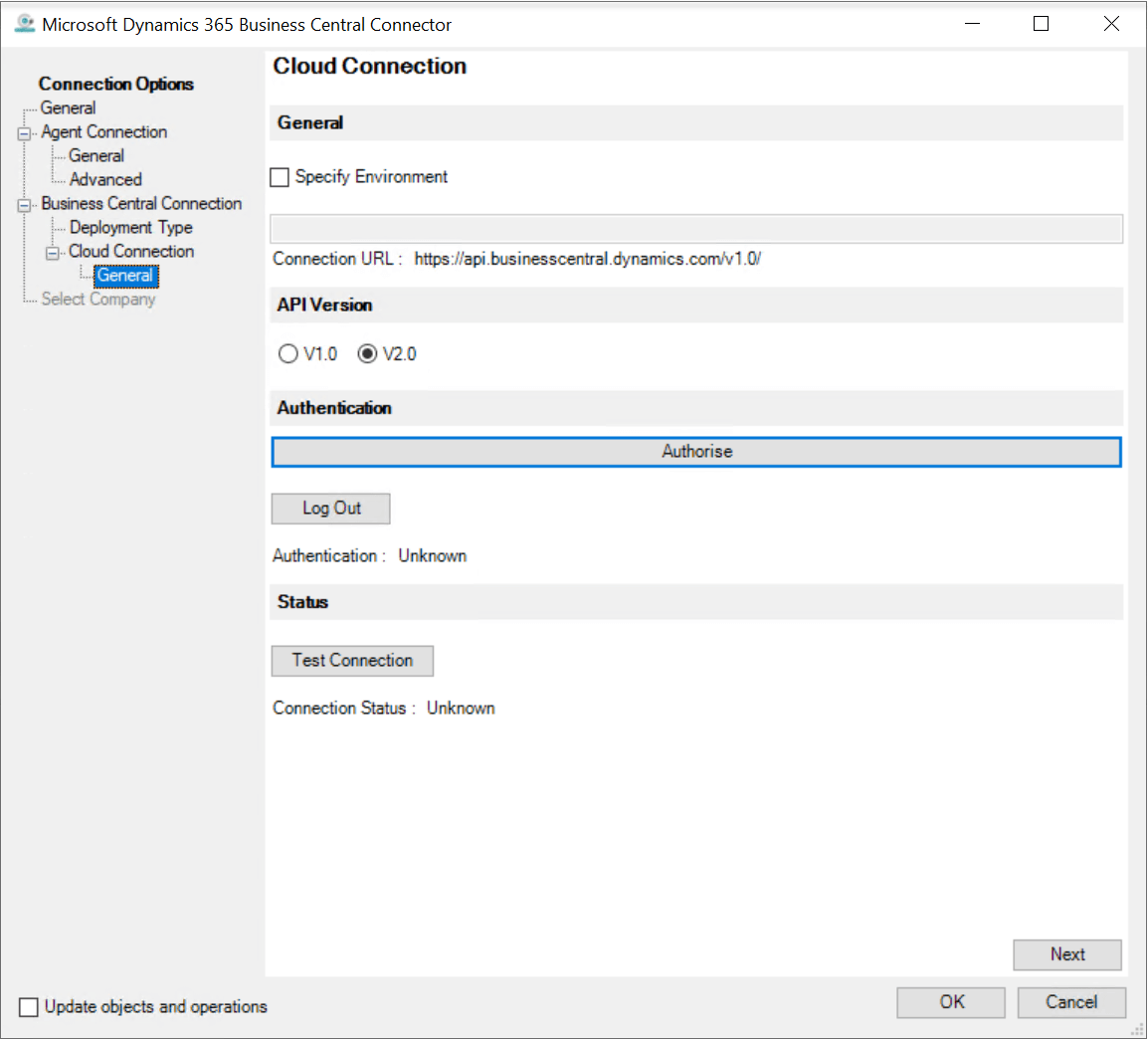
API Version selection determines the Microsoft Dynamics 365 Business Central API version used. Both API V1.0 and V2.0 are supported with API V2.0 being selected by default for new connections. API V2.0 is supported in Microsoft Dynamics 365 Business Central 2020 Wave 2 and higher, providing access to a greater selection of business objects. API V1.0 is supported in Microsoft Dynamics 365 Business Central 2019 Spring Update and higher.”
For standard cloud deployments, click Authorise and enter the database user credentials required to access the company database for this connection.
When deploying Microsoft Dynamics 365 Business Central to the cloud, you can choose to create separate environments, for example, for production and “live” purposes (for more information, refer to your Microsoft documentation). To connect to such an environment, select Specify Environment and enter the environment name in the box below — Connection URL shows the URL the Agent uses to connect to this environment and API. Then click Authorise and enter the database user credentials required to access the company database for this connection.
Use Test Connection to ensure the Microsoft Dynamics 365 Business Central Agent can connect to the database successfully.
Use Log Out to disconnect the Agent from the API.
About the On-Premise Connection Node
The On-Premise Connection node provides a brief summary of the configured connection to Microsoft Dynamics 365 Business Central when on-premise.
About the General Node
The General tab is only available when On-Premise is selected in the Deployment Type node.
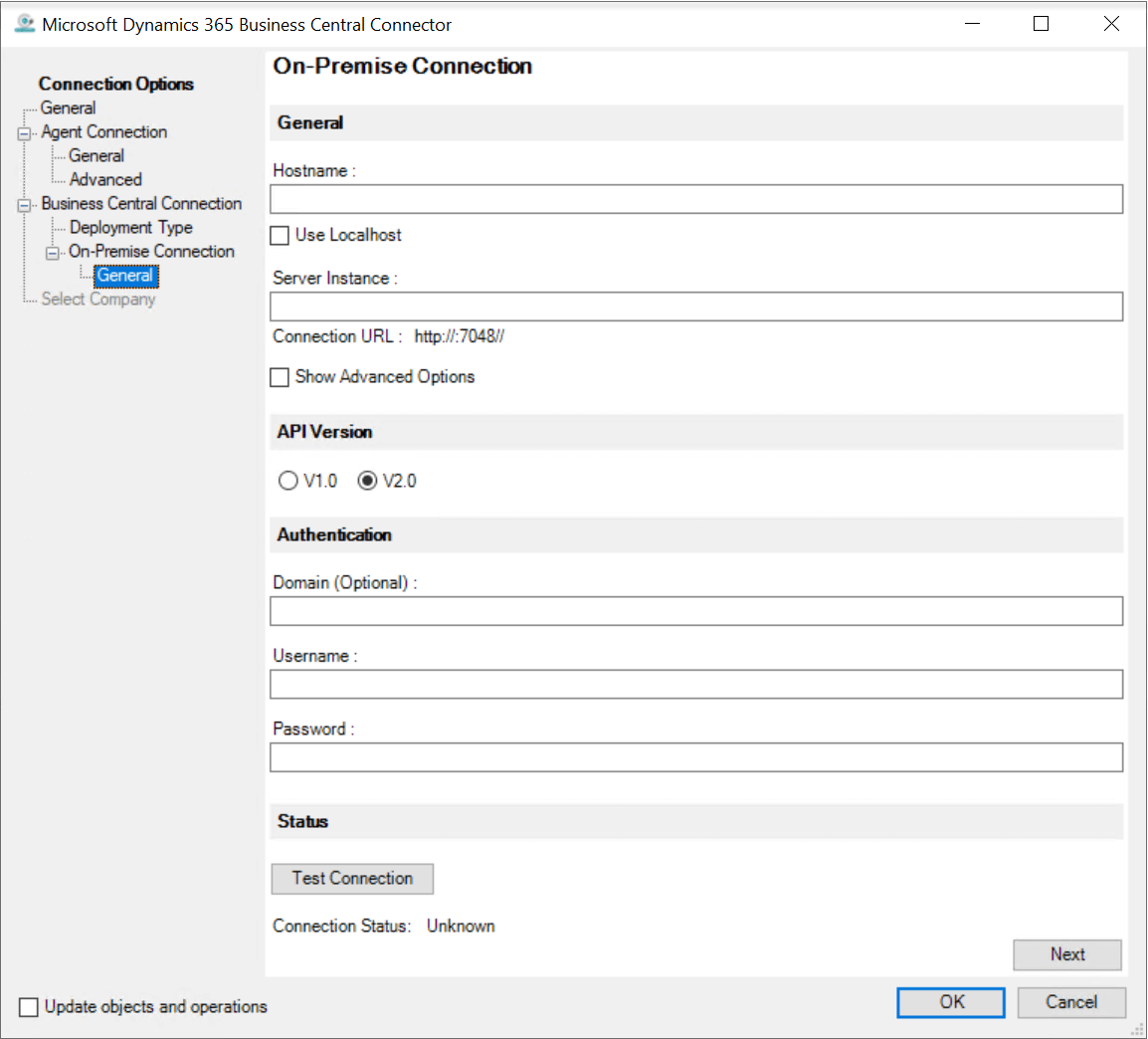
Use the parameters in this node to create a connection to the Microsoft Dynamics 365 Business Central server instance hosting the company database you want to run tasks against.
Specifying the Server Instance
Provide the Hostname or IP address of the machine hosting the Microsoft Dynamics 365 Business Central client.
In Server Instance, enter the configured name for this instance.
By default, the connection is over HTTP and port 7048. If the server instance has been set up to use HTTPS or a different port, enable Show Advanced Options. The advanced node appears under On-Premise Connection.
The URL to the Microsoft Dynamics 365 Business Central on-premise API is automatically built from the configuration you enter above — see underneath Server Instance.
API Version Selection
API Version selection determines the Microsoft Dynamics 365 Business Central API version used. Both API V1.0 and V2.0 are supported with API V2.0 being selected by default for new connections. API V2.0 is supported in Microsoft Dynamics 365 Business Central 2020 Wave 2 and higher, providing access to a greater selection of business objects. API V1.0 is supported in Microsoft Dynamics 365 Business Central 2019 Spring Update and higher.
Specifying Database Credentials
You must provide the Username and Password allocated to the Microsoft Dynamics 365 Business Central Agent. They must allow full access to the company database. Domain credentials can be used if required.
Use Test Connection to ensure the Microsoft Dynamics 365 Business Central Agent can connect to the database successfully.
About the Advanced Node
Use the Advanced node to change the communication defaults to the on-premise API. This node is hidden until enable Show Advanced Options in the On-Premise Connection > General node is selected.
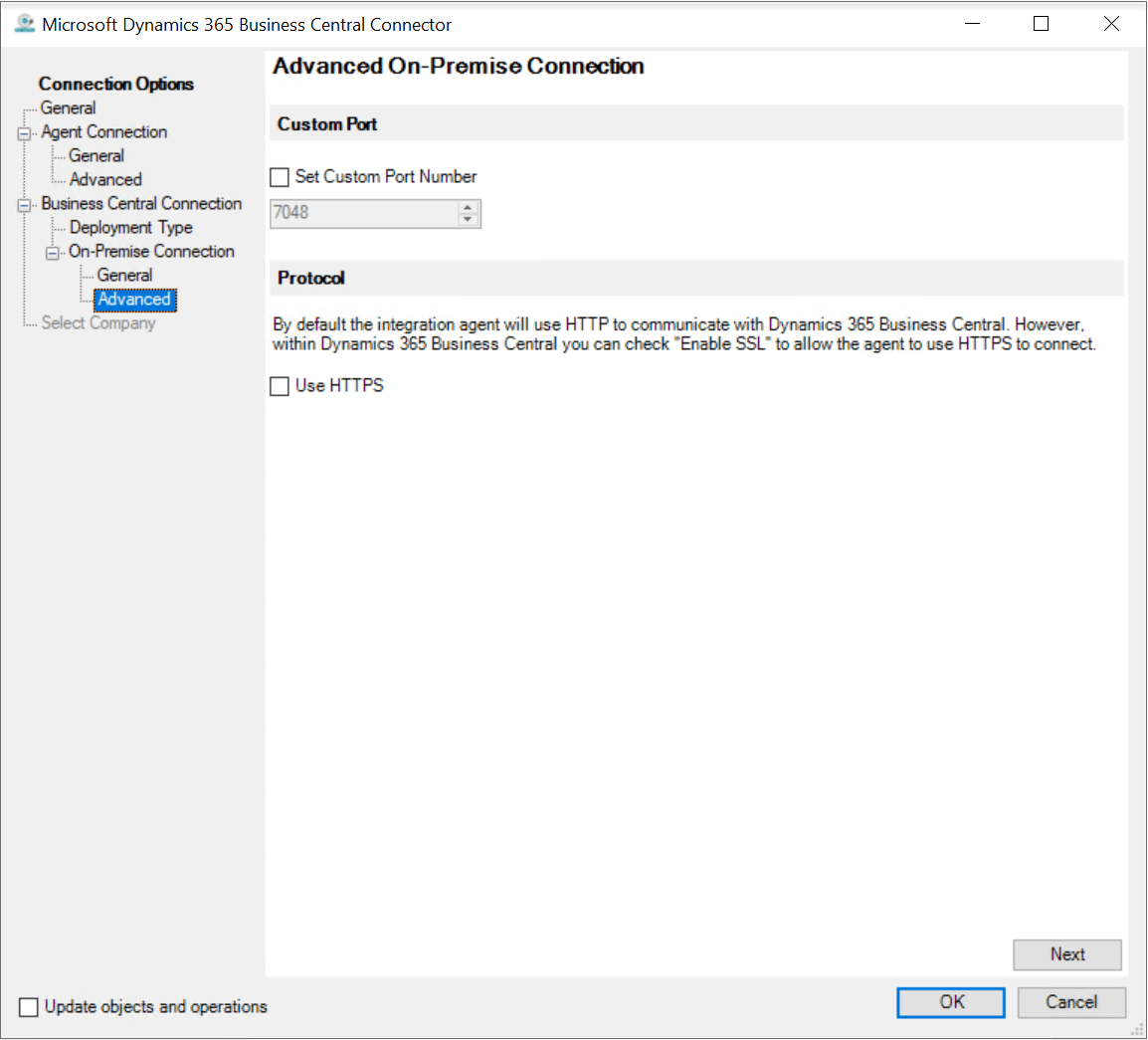
By default, the connection is over HTTP and port 7048.
To change the port used to communicate over, select Set Custom Port Number and enter the required number in the box provided.
To use HTTPS communication, select Use HTTPS.
About the Select Company Node
Use the Select Company node to choose the Microsoft Dynamics 365 Business Central database this Agent is specifically monitoring.
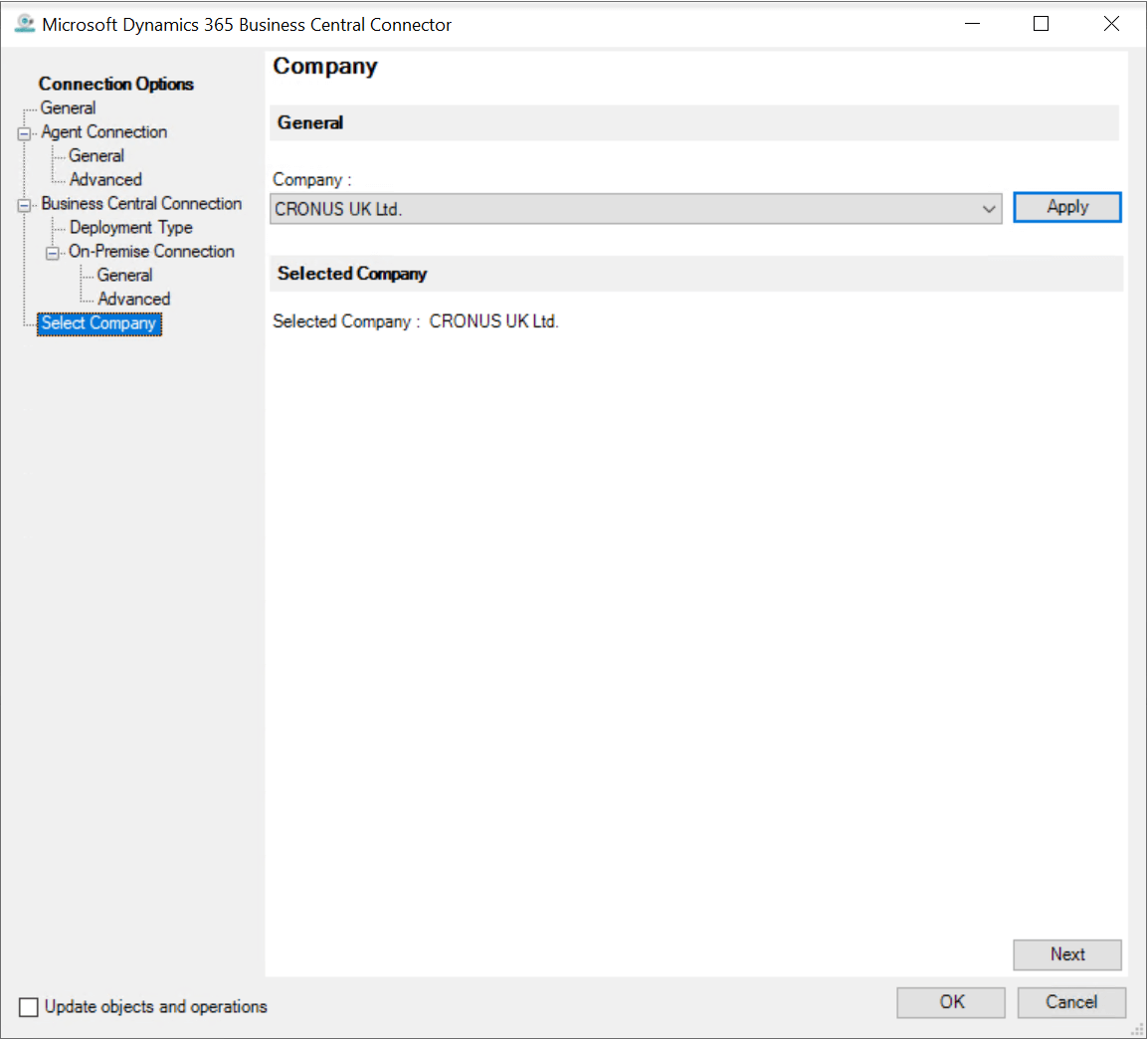
If your Microsoft Dynamics 365 Business Central Agent is installed on a machine hosting more than one company database, you must create a separate global connection for each database you want tasks to access.
Microsoft Dynamics 365 Business Central Connector – Step Configuration
When creating new tasks, the Microsoft Dynamics 365 Business Central Connector tool is located under the Data Connectors category in the Task Browser.
To add a new Microsoft Dynamics 365 Business Central Connector step to an existing task, do the following:
From the relevant task, either:
- Click and drag the Microsoft Dynamics 365 Business Central Connector icon from the Task Browser to the task Design area.
- From the task’s Design tab, right-click on empty space and select New > Data Connectors > Microsoft Dynamics 365 Business Central Connector.
For a detailed description of how to create new tasks, refer to the product help.
About the General Tab
Use the General tab to choose the BPA Platform data source to be mapped to the Microsoft Dynamics 365 Business Central objects. The data source must be in XML form. To map BPA Platform recordsets, configure a Convert Recordset to XML or Transform Data step in the task before the Microsoft Dynamics 365 Business Central Connector step, then select this as Task step (see below).
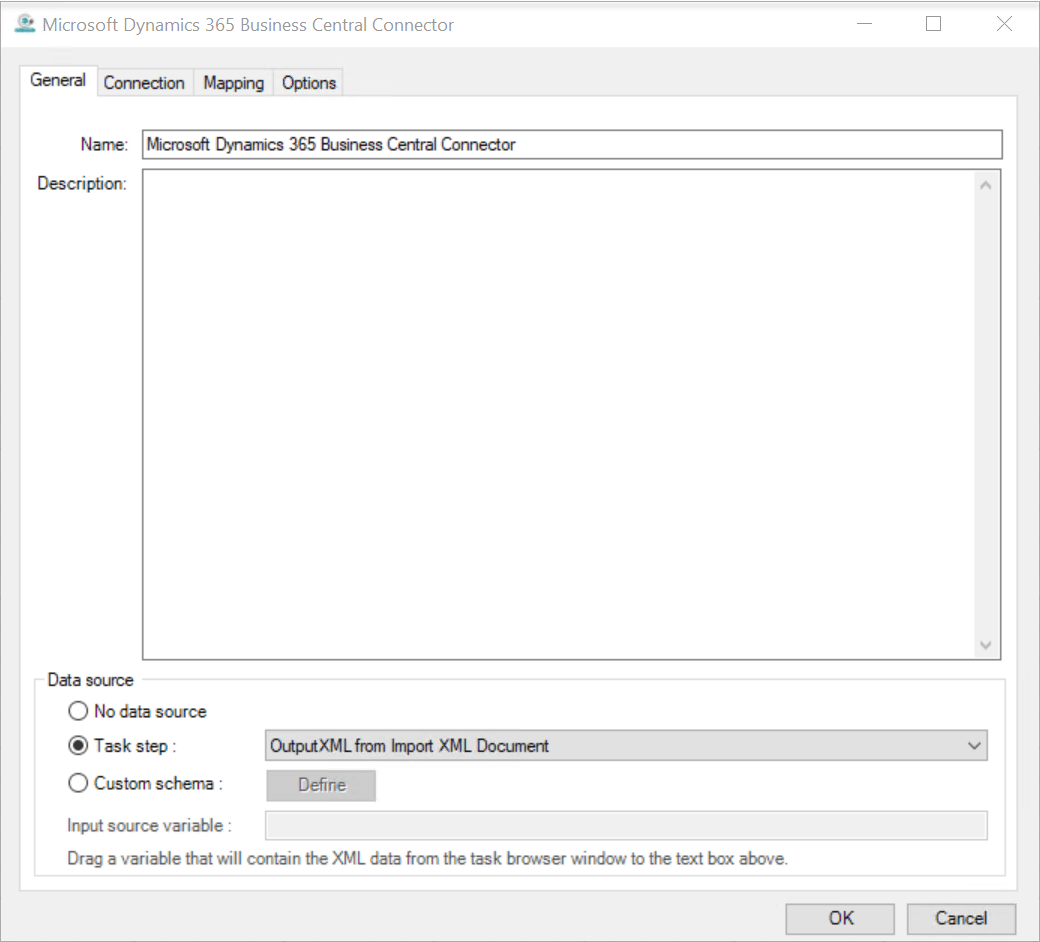
Provide a meaningful Name and Description for this step.
Data source can either be:
- No data source — If you do not make use of a dedicated XML input source, select this option to use BPA Platform variables in place of the XML objects’ fields.
For example, you can extract various bits of information from an email and store them in BPA Platform variables. The variables are then mapped to Microsoft Dynamics 365 Business Central operational objects and fields which are passed to the API at task runtime. - Task step — The data source can be set to an available BPA Platform XML data source.
Only those steps that are capable of natively exposing an XML document at runtime are listed. This may be another Microsoft Dynamics 365 Business Central Connector step, or a tool such as Convert Recordset to XML or Transform Data. - Custom schema — An XML schema defines the structure of the parsed XML: what tags are present, and the nesting of the tags. You Define the schema of the XML that is used as the input data source for this step. The Microsoft Dynamics 365 Business Central Connector tool uses the industry standard XSD format. Any XML processed by this step must conform to this schema else an error will be reported. If the XSD schema is available, either import it into the Custom Schema Configuration (use the Import XSD/XML File button), or copy and paste it into the configuration box.

If the XSD schema is not available, you can import an example of the runtime XML (Import XSD/XML File), or copy and paste it into the configuration box. Use the Parse button to create the schema.- Input source variable — As well as defining the schema, specify the BPA Platform variable that contains the XML data at runtime.
About the Connection Tab
You must specify the Microsoft Dynamics 365 Business Central connection (see Global Configuration) this task step must use.
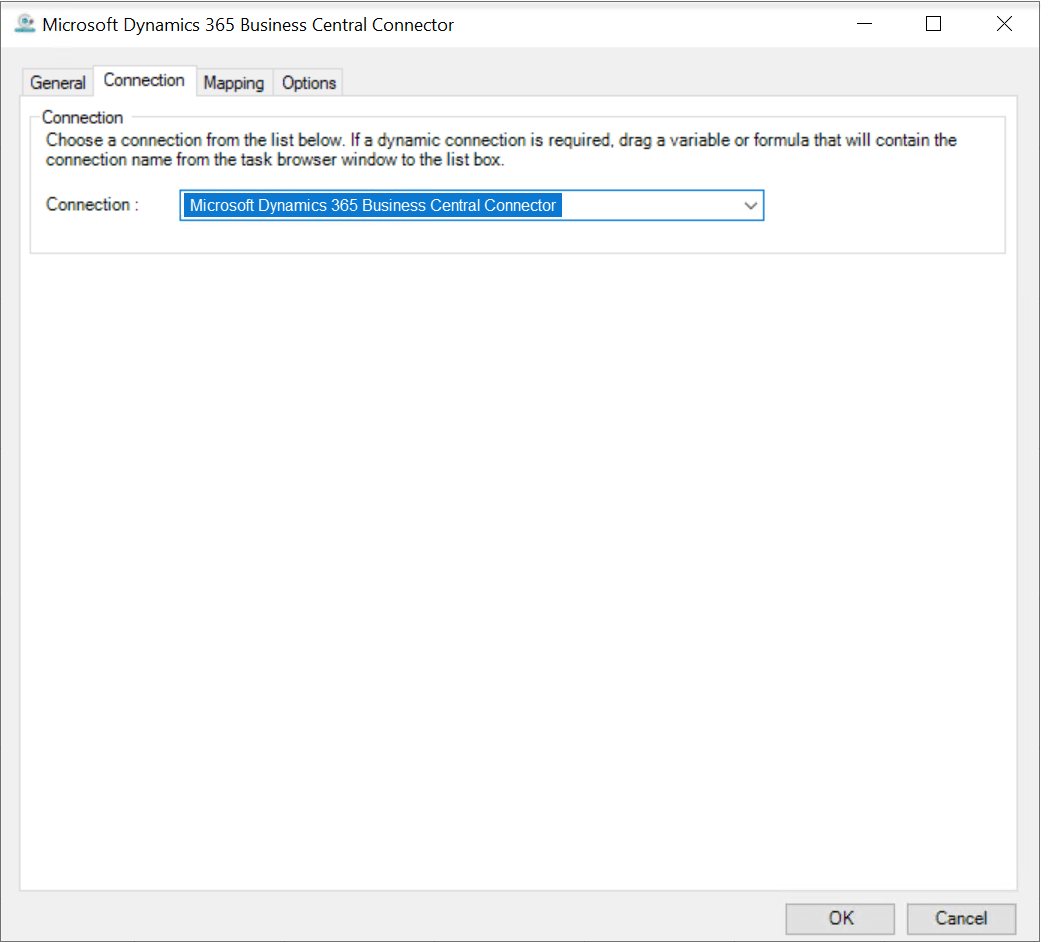
All connections created in the global configuration window are presented here.
Alternatively, you can use a BPA Platform variable or formula to create a dynamic connection, where the connection used is determined by runtime circumstances. At runtime, the contents of the variable must match the name of one of the global connections — this is case-sensitive. To do this, you must install a Microsoft Dynamics 365 Business Central Agent for each individual company database you want to monitor (even though access is through the same API). All Agents must be registered with the BPA Platform server and a separate global connection created for each Agent.
About the Mapping Tab
Use the Mapping tab to define links between the data source XML (see About the General Tab) and those required by Microsoft Dynamics 365 Business Central. This defines how, at runtime, the incoming XML is to be translated into the XML required for the relevant object and operation.
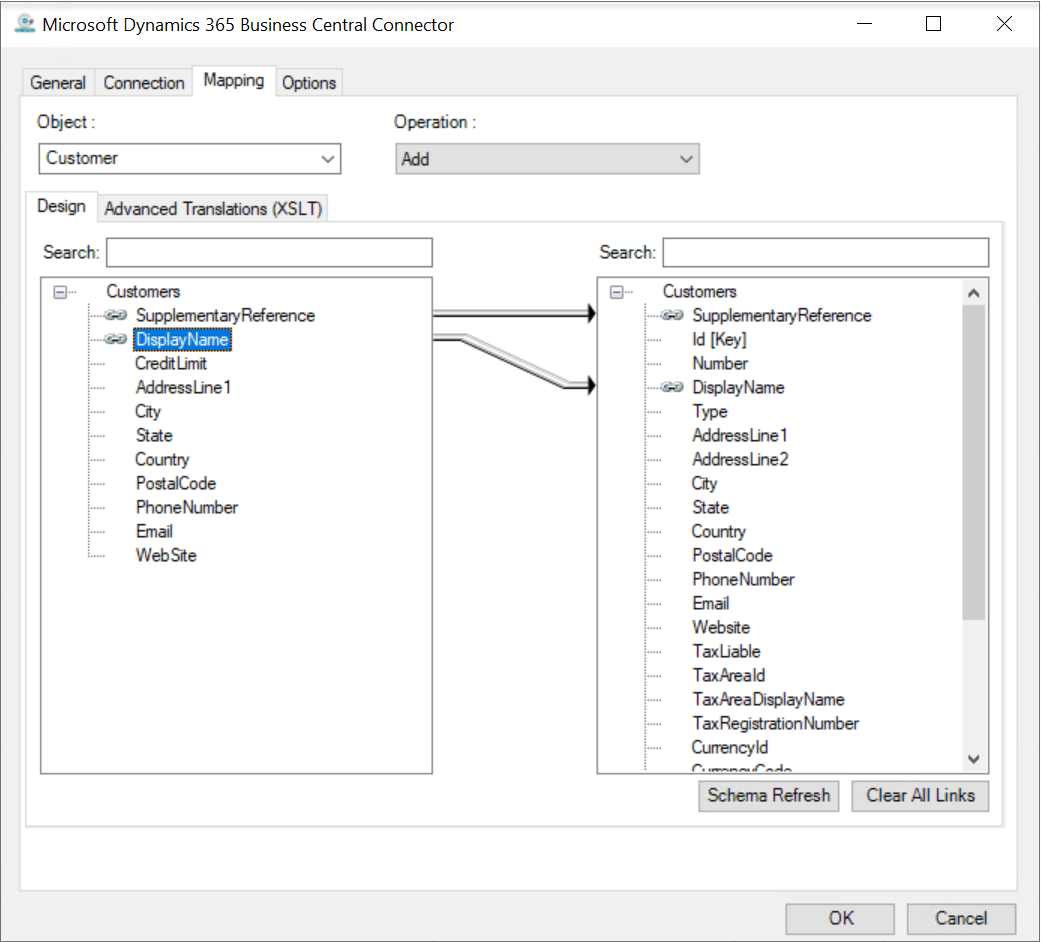
The Object drop-down shows the Microsoft Dynamics 365 Business Central objects. The Operations drop-down shows the operations available for the selected Object
Further down, the left-hand XML tree structure shows those data source fields available for mapping . The right-hand XML tree structure displays those input fields for the selected Object and Operation.
Creating Mappings
Create links by dragging and dropping a data source field (left) onto its corresponding Microsoft Dynamics 365 Business Central Connector input field (right). Only linked fields are used in the output XML.
BPA Platform formulas and variables can be included in the source data even when using a Task step or Custom schema — drag them from the Task Browser to the data source’s XML; these can then be linked to the relevant input fields. BPA Platform recordsets must first be converted to XML using either the Convert Recordset to XML or Transform Data tool before they can be used here.
Each operation has an additional field, SupplementaryReference, which allows for traceability when transferring data from one place to another. When mapped, the data resides locally at runtime. It is added to the output, and creates a record for reference purposes only — you can choose to map any field to SupplementaryReference to assist with checking where the data originated from or at what time the data transfer occurred, for example.
The Microsoft Dynamics 365 Business Central Connector tool uses eXtensible Stylesheet Language Transformations (XSLT) to translate the received XML. The Advanced Translations (XSLT) tab shows the XSLT generated for the links created for the object and operation. Use Enable Free Type Mode to directly edit the XSLT — this is particularly useful when translating a non-standard requirement.
Refreshing the Microsoft Dynamics 365 Business Central Schema
If new fields, objects, and operations have been added to your Microsoft Dynamics 365 Business Central instance after this task step was originally created, use Schema Refresh to make the latest API metadata available for use (first ensure Update Objects and Operations is selected in the relevant global connection).
Using Filters with Objects
When using SEARCH operations, you can make use of filters to limit the data involved. At runtime, these fields are treated as “where clauses”.
By default, all mapped fields are treated as “equal to” filters. To set a filter condition, right-click the required field and select Set Filter Condition. Change the filter condition as required.
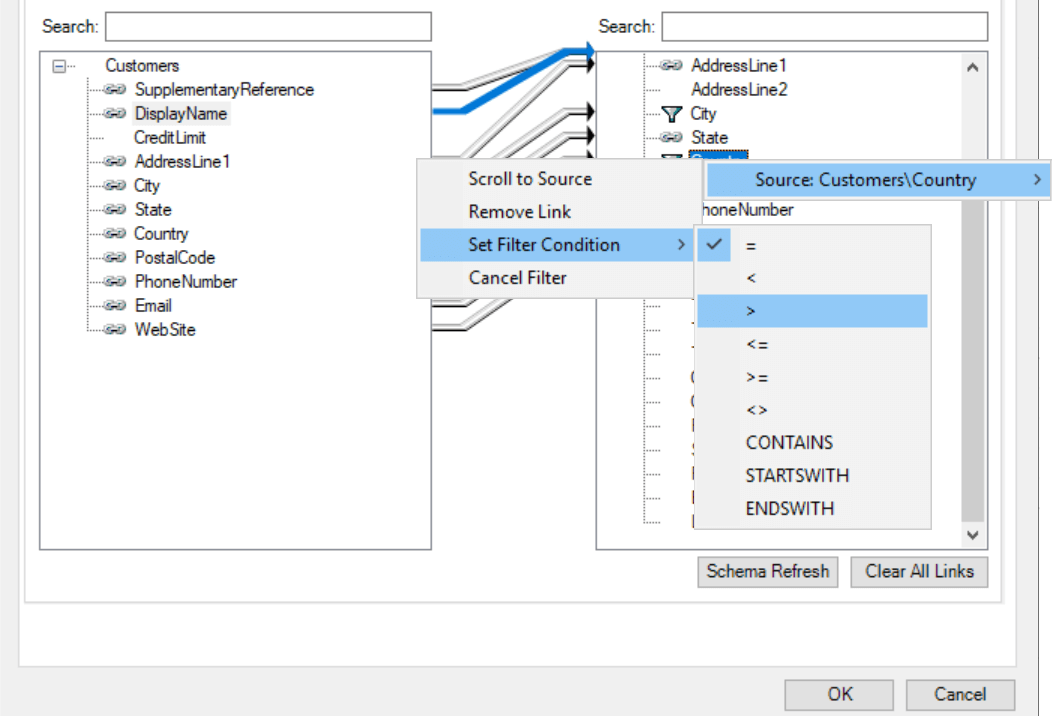
Available filter conditions are:
| Filter | Description |
|---|---|
| = | Filter results where the input source value must be equal to the mapped data source value. |
| <> | Filter results where the input source value is not equal to the mapped data source value. |
| < | Filter results where the input source value is less than the mapped data source value. |
| > | Filter results where the input source value is greater than the mapped data source value. |
| <= | Filter results where the input source value is less than or equal to the mapping data source value. |
| >= | Filter results where the input source value is more than or equal to the mapping data source value. |
| STARTSWITH | Filter results where the data source value starts with a specified string. |
| ENDSWITH | Filter results where the data source value ends with a specified string. |
| CONTAINS | Filter results where the data source value contains a specified string. |
The presence of multiple filter fields implies that all conditions must be met. Nominated fields must be mapped to be included in the output XML.
Supported Objects
The following objects and operations are supported in this release of the Microsoft Dynamics 365 Business Central Connector:
| Object | Operations | ||||||
|---|---|---|---|---|---|---|---|
| READ | ADD | UPDATE | DELETE | SEARCH | Additional Supported | ||
| Account | ID | No mandatory fields for the SEARCH operation. | |||||
| Aged Accounts Payable | VendorID | No mandatory fields for the SEARCH operation. | |||||
| Aged Accounts Receivable | CustomerID | No mandatory fields for the SEARCH operation. | |||||
| Apply Vendor Entry – API V2.0 Only | ID | No mandatory fields for the SEARCH operation. | |||||
| Attachments | ParentID – API v1.0 Only ID | No mandatory fields for the ADD operation; the keys are auto-generated if not mapped. | ParentID – API v1.0 Only ID | ParentID – API v1.0 Only ID | No mandatory fields for the SEARCH operation. | ||
| Balance Sheet | LineNumber – API V1.0 Only ID | No mandatory fields for the SEARCH operation. | |||||
| Bank Account | ID | No mandatory fields for the ADD operation; the keys are auto-generated if not mapped. | ID | ID | No mandatory fields for the SEARCH operation. | ||
| Cash Flow Statement | LineNumber – API V1.0 Only ID | No mandatory fields for the SEARCH operation. | |||||
| Company Information | ID | ID NOTE: If updating the address for a record, you must send through all lines of the address not just the affected line. Sending a partial address may cause the address to be deleted, leaving only the updated lines. | No mandatory fields for the SEARCH operation. | ||||
| Contact – API V2.0 | ID | No mandatory fields for the ADD operation; the keys are auto-generated if not mapped. | ID | ID | No mandatory fields for the SEARCH operation. | ||
| Contact Information – API V2.0 | ContactID | No mandatory fields for the SEARCH operation. | |||||
| Country Region | ID | No mandatory fields for the ADD operation; the keys are auto-generated if not mapped. | ID | ID | No mandatory fields for the SEARCH operation. | ||
| Currency | ID | No mandatory fields for the ADD operation; the keys are auto-generated if not mapped. | ID | ID | No mandatory fields for the SEARCH operation. | ||
| Customer Financial Detail | ID | No mandatory fields for the SEARCH operation. | |||||
| Customer Payment Journal | ID | No mandatory fields for the ADD operation; the keys are auto-generated if not mapped. | ID | ID | No mandatory fields for the SEARCH operation. | ||
| Customer Payment | ID | Although this operation is available, you cannot add a Customer Payment record in isolation. It must be done as part of the new Customer Payment Journal record or as an update to Customer Payment Journal. | ID | ID | No mandatory fields for the SEARCH operation. | ||
| Customer Return Reason – API V2.0 Only | ID | No mandatory fields for the ADD operation; the keys are auto-generated if not mapped. | ID | ID | No mandatory fields for the SEARCH operation. | ||
| Customer | ID | No mandatory fields for the ADD operation; the keys are auto-generated if not mapped. | ID NOTE: If updating the address for a record, you must send through all lines of the address and not just the affected line. Sending a partial address may cause the address to be deleted, leaving only the updated lines | ID | No mandatory fields for the SEARCH operation. | ||
| Customer Sale | CustomerID CustomerNumber Name | No mandatory fields for the SEARCH operation. | |||||
| Default Dimensions | ParentID – API V1.0 Only DimensionID – API V1.0 Only ID – API V2.0 Only | No mandatory fields for the ADD operation; the keys are auto-generated if not mapped. | ParentID – API V1.0 Only DimensionID – API V1.0 Only ID – API V2.0 Only | ParentID – API V1.0 Only DimensionID – API V1.0 Only ID – API V2.0 Only | No mandatory fields for the SEARCH operation. | ||
| Dimension Line | ID ParentID | No mandatory fields for the ADD operation; the keys are auto-generated if not mapped. | ID ParentID | ID ParentID | No mandatory fields for the SEARCH operation. | ||
| Dimension Set – API V2.0 Only | ID | No mandatory fields for the ADD operation; the keys are auto-generated if not mapped. | ID ParentID | ID ParentID | No mandatory fields for the SEARCH operation. | ||
| Dimension Value | ID | No mandatory fields for the SEARCH operation. | |||||
| Dimension | ID | No mandatory fields for the SEARCH operation. | |||||
| Employee | ID | No mandatory fields for the ADD operation; the keys are auto-generated if not mapped. | ID ID NOTE: If updating the address for a record, you must send through all lines of the address not just the affected line. Sending a partial address may cause the address to be deleted, leaving only the updated lines. | ID | No mandatory fields for the SEARCH operation. | ||
| General Ledger Entry | ID | No mandatory fields for the SEARCH operation. | |||||
| General Ledger Entry Attachments | GeneralLedger EntryNumber ID | No mandatory fields for the ADD operation; the keys are auto-generated if not mapped. | GeneralLedger EntryNumber ID | GeneralLedger EntryNumber ID | No mandatory fields for the SEARCH operation. | ||
| General Product Posting Group – API V2.0 Only | ID | No mandatory fields for the SEARCH operation. | |||||
| Income Statement | LineNumber | No mandatory fields for the SEARCH operation. | |||||
| Inventory Posting Group – API V2.0 Only | ID | No mandatory fields for the SEARCH operation. | |||||
| Item Category | ID | No mandatory fields for the ADD operation; the keys are auto-generated if not mapped. | ID | ID | No mandatory fields for the SEARCH operation. | ||
| Item | ID | No mandatory fields for the ADD operation; the keys are auto-generated if not mapped. | ID | ID | No mandatory fields for the SEARCH operation. | ||
| Item Ledger Entry – API V2.0 Only | ID | No mandatory fields for the SEARCH operation. | |||||
| Journal Line | ID | Although this operation is available, you cannot add a Journal Line record in isolation. It must be done as part of the new Journal record or as an update to Journal. | ID | ID | No mandatory fields for the SEARCH operation. | ||
| Journal | ID | No mandatory fields for the ADD operation; the keys are auto-generated if not mapped. | ID | ID | No mandatory fields for the SEARCH operation. | POST – ID | |
| Location – API V2.0 Only | ID | No mandatory fields for the ADD operation; the keys are auto-generated if not mapped. | ID | ID | No mandatory fields for the SEARCH operation. | ||
| Opportunity – API V2.0 Only | ID | No mandatory fields for the ADD operation; the keys are auto-generated if not mapped. | ID | ID | No mandatory fields for the SEARCH operation. | ||
| Payment Method | ID | No mandatory fields for the ADD operation; the keys are auto-generated if not mapped. | ID | ID | No mandatory fields for the SEARCH operation. | ||
| Payment Term | ID | No mandatory fields for the ADD operation; the keys are auto-generated if not mapped. | ID | ID | No mandatory fields for the SEARCH operation. | ||
| PDF Document | ID | No mandatory fields for the SEARCH operation. | |||||
| Picture | ID | ID | ID | No mandatory fields for the SEARCH operation. | |||
| Project | ID | No mandatory fields for the ADD operation; the keys are auto-generated if not mapped. | ID | ID | No mandatory fields for the SEARCH operation. | ||
| Purchase Invoice Line | ID | Although this operation is available, you cannot add a Purchase Invoice Line record in isolation. It must be done as part of the new Purchase Invoice record or as an update to Purchase Invoice. | ID | ID | No mandatory fields for the SEARCH operation. | ||
| Purchase Invoice | ID | No mandatory fields for the ADD operation; the keys are auto-generated if not mapped. | ID NOTE: If updating the address for a record, you must send through all lines of the address not just the affected line. Sending a partial address may cause the address to be deleted, leaving only the updated lines. | ID | No mandatory fields for the SEARCH operation. | POST – ID | |
| Purchase Order Line – API V2.0 Only | ID | No mandatory fields for the ADD operation; the keys are auto-generated if not mapped. | ID | ID | No mandatory fields for the SEARCH operation. | ||
| Purchase Order – API V2.0 Only | ID | No mandatory fields for the ADD operation; the keys are auto-generated if not mapped. | ID | ID | No mandatory fields for the SEARCH operation. | RECEIVED AND INVOICE – ID | |
| Purchase Receipt Line – API V2.0 Only | ID | No mandatory fields for the SEARCH operation. | |||||
| Purchase Receipt- API V2.0 Only | ID | No mandatory fields for the SEARCH operation. | |||||
| Retained Earning Statement | LineNumber | No mandatory fields for the SEARCH operation. | |||||
| Sales Credit Memo Line | ID | Although this operation is available, you cannot add a Sales Credit Memo Line record in isolation. It must be done as part of the new Sales Credit Memo record or as an update to Sales Credit Memo. | ID | ID | No mandatory fields for the SEARCH operation. | ||
| Sales Credit Memo | ID NOTE: The child object Pdf Document is not returned unless a POST operation has been performed for the Sales Credit Memo record which includes the PDF Document. | No mandatory fields for the ADD operation; the keys are auto-generated if not mapped. | ID NOTE: If updating the address for a record, you must send through all lines of the address not just the affected line. Sending a partial address may cause the address to be deleted, leaving only the updated lines. | ID | No mandatory fields for the SEARCH operation. | CANCEL AND SEND — IDCANCEL — IDPOST AND SEND — ID POST — IDSEND — ID | |
| Sales Invoice Line | ID | Although this operation is available, you cannot add a Sale Invoice Lines record in isolation. It must be done as part of the new Sales Invoice record or as an update to Sales Invoice. | ID | ID | No mandatory fields for the SEARCH operation. | ||
| Sales Invoice | ID | No mandatory fields for the ADD operation; the keys are auto-generated if not mapped. | ID NOTE: If updating the address for a record, you must send through all lines of the address not just the affected line. Sending a partial address may cause the address to be deleted, leaving only the updated lines. | ID | No mandatory fields for the SEARCH operation. | CANCEL AND SEND — IDCANCEL — IDPOST AND SEND — ID POST — IDSEND — IDMAKE CORRECTIVE — IDCREDIT MEMO — ID | |
| Sales Order Line | ID | Although this operation is available, you cannot add a Sales Order Line record in isolation. It must be done as part of the new Sales Order record or as an update to Sales Order. | ID | ID | No mandatory fields for the SEARCH operation. | ||
| Sales Order | ID | No mandatory fields for the ADD operation; the key is auto-generated if not mapped. | ID NOTE:If updating the address for a record, you must send through all lines of the address not just the affected line. Sending a partial address may cause the address to be deleted, leaving only the updated lines. | ID | No mandatory fields for the SEARCH operation. | SHIP AND INVOICE — ID | |
| Sales Quote Line | ID | Although this operation is available, you cannot add a Sales Quote Line record in isolation. It must be done as part of the new Sales Quote record or as an update to Sales Quote. | ID | ID | No mandatory fields for the SEARCH operation. | ||
| Sales Quote | ID | No mandatory fields for the ADD operation; the key is auto- generated if not mapped. | ID NOTE: If updating the address for a record, you must send through all lines of the address not just the affected line. Sending a partial address may cause the address to be deleted, leaving only the updated lines. | ID | ID No mandatory fields for the SEARCH operation. | MAKE INVOICE — IDSEND — IDMAKE ORDER — ID | |
| Shipment Method | ID | No mandatory fields for the ADD operation; the key is auto- generated if not mapped. | ID | ID | No mandatory fields for the SEARCH operation. | ||
| Sales Shipment Line – API V2.0 Only | ID | No mandatory fields for the SEARCH operation. | |||||
| Sales Shipment – API V2.0 Only | ID | No mandatory fields for the SEARCH operation. | |||||
| Tax Area | ID | No mandatory fields for the ADD operation; the key is auto-generated if not mapped. | ID | ID | No mandatory fields for the SEARCH operation. | ||
| Tax Group | ID | No mandatory fields for the ADD operation; the key is auto-generated if not mapped. | ID | ID | No mandatory fields for the SEARCH operation. | ||
| Time Registration Entry | ID | No mandatory fields for the ADD operation; the key is auto-generated if not mapped. | ID | ID | No mandatory fields for the SEARCH operation. | ||
| Trial Balance | Number | No mandatory fields for the SEARCH operation. | |||||
| Unit of Measure | ID | No mandatory fields for the ADD operation; the key is auto-generated if not mapped. | ID | ID | No mandatory fields for the SEARCH operation. | ||
| Vendor Purchase | Name VendorID VendorNumber | No mandatory fields for the SEARCH operation. | |||||
| Vendor | ID | No mandatory fields for the ADD operation; the key is auto-generated if not mapped | ID NOTE: If updating the address for a record, you must send through all lines of the address not just the affected line. Sending a partial address may cause the address to be deleted, leaving only the updated lines. | ID | No mandatory fields for the SEARCH operation. | ||
| Vendor Payment Journal – API V2.0 Only | ID | No mandatory fields for the ADD operation; the key is auto-generated if not mapped | ID | ID | No mandatory fields for the SEARCH operation. | ||
| Vendor Payment – API V2.0 Only | ID | No mandatory fields for the ADD operation; the key is auto-generated if not mapped | ID | ID | No mandatory fields for the SEARCH operation. | ||
Their operations are as follows:
- Pages —
READ,ADD,UPDATE,DELETE,SEARCH - Queries —
READ,SEARCH - Codeunits — The function used by the codeunit is displayed as the operation, for example, for a workflow codeunit you might have
APPROVEandREJECT.
For more information about using codeunits in Microsoft Dynamics 365 Business Central, refer to your Microsoft documentation
A Note About Updating Child Objects From Parent Objects
If performing an UPDATE on an object that has child objects where you are updating parent-level and child-level fields, how you map the child-level fields determines whether a new child record is added or an existing child record updated:
- If a child object has all [Key] fields mapped, this is treated as an
UPDATEoperation — The mapped keys are used to find the relevant record. - If a child-level [Key] field is not mapped but a child-level field is, this is treated as an
ADDoperation — A new child record is added with the relevant keys auto-generated.
For example, this mapping adds a new Picture child record against the mapped Employee ID.

- If a child object has more than one [Key] field but only one is mapped, again this is treated as an
ADDoperation — A new child record is added with the unmapped keys auto-generated.
For example, the child object, DefaultDimensions, has two [Key] fields but only one is mapped. For this scenario, a new DefaultDimensions record is added with the ParentID being auto-generated.

- Some objects have more than one child objects. Those child objects that are not involved in the mapping are not affected by the
UPDATEoperation at task runtime. For example, the Employee object has three child objects: Picture, DefaultDimensions, and TimeRegistrationEntries. This mapping does not affect any existing child records for DefaultDimensions or TimeRegistrationEntries.

The following table indicates those objects with child-level objects and their [Key] fields:
| Object | Child Object | [Key] Field |
|---|---|---|
| Customer Payment Journal | CustomerPayments | ID |
| Customer Payments | DimensionSetLines | ID |
| Customer | DefaultDimensions | ID |
| ContactsInformation | ContactID | |
| Employee | DefaultDimensions | ID |
| TimeRegistrationEntries | ID | |
| Item | DefaultDimensions | ID |
| ItemVariants | ID | Journal Line | Attachments | ID ID | DimensionSetLines | ID |
| Journal | JournalLines | ID |
| Purchase Order Line | DimensionSetLines | ID |
| PurchaseInvoice | DimensionSetLines | ID |
| Attachments | ID | |
| PurchaseInvoiceLines | ID | |
| Sales Credit Memo Line | DimensionSetLines | ID |
| Sales Credit Memo | DimensionSetLines | ID |
| Sales Credit Memo | SalesCreditMemoLines | ID |
| Sales Invoice Line | DimensionSetLines | ID |
| Sales Invoice | DimensionSetLines | ID |
| SalesOrderLines | ID | |
| Attachments | ID | |
| Sales Order Line | DimensionSetLines | ID |
| Sales Order | DimensionSetLines | ID |
| SalesOrderLines | ID | |
| Attachments | ID | |
| Sales Quote Line | DimensionSetLines | ID |
| Sales Quote | DimensionSetLines | ID |
| SalesQuoteLines | ID | |
| Attachments | ID | |
| Time Registration Entry | DimensionSetLines | ID |
| Vendor Payment Journal | VendorPayments | ID |
| Vendor Payment | DimensionSetLines | ID |
| ApplyVendorEntries | ID | |
| Vendor | DefaultDimensions | ID |
| ContactsInformation | ContactID |
About the Options Tab
The Options tab allows you to define how errors in this step are handled at task runtime.
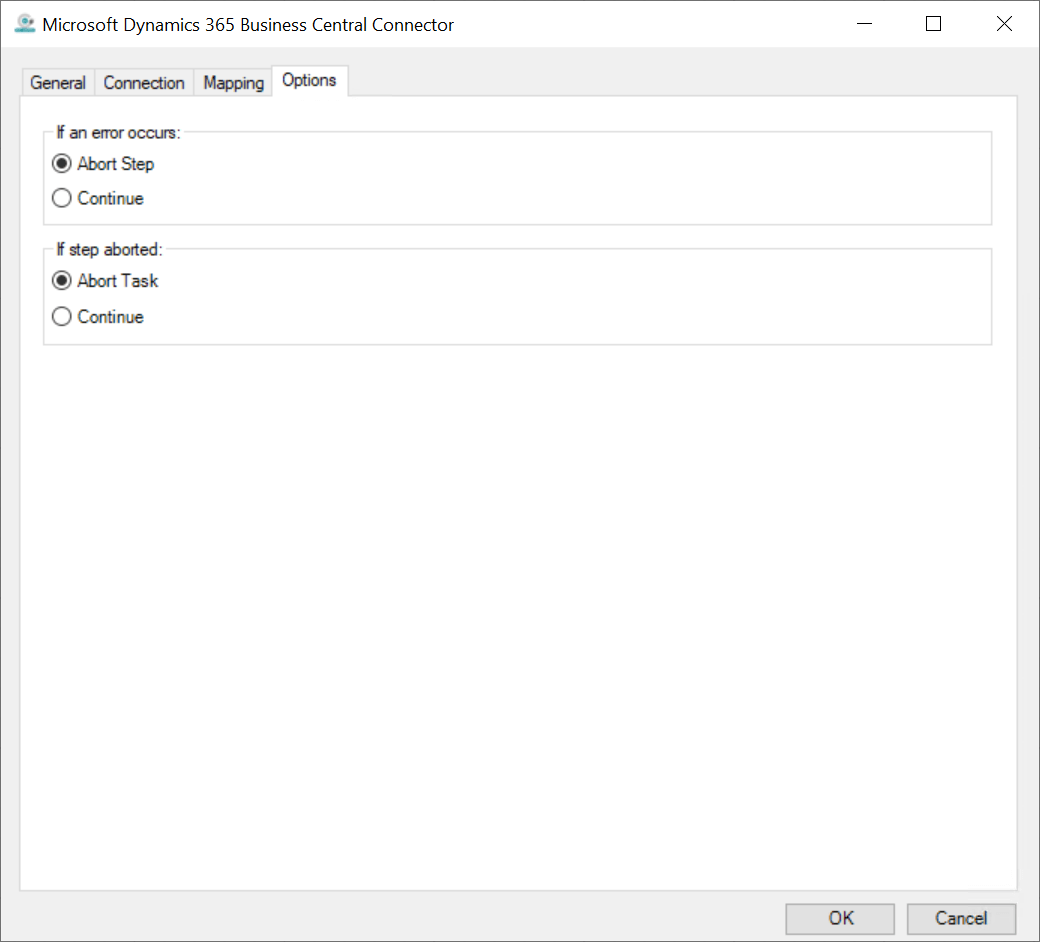
If an error occurs, you can decide whether the step should Continue processing, or terminate the step immediately
(Abort Step).
If the step is aborted, you can choose to Continue processing onto the next step in the task, or terminate the whole task immediately (Abort Task). By allowing the task to Continue, you can use the error XML received back in a Save File step for investigation purposes, for example.
